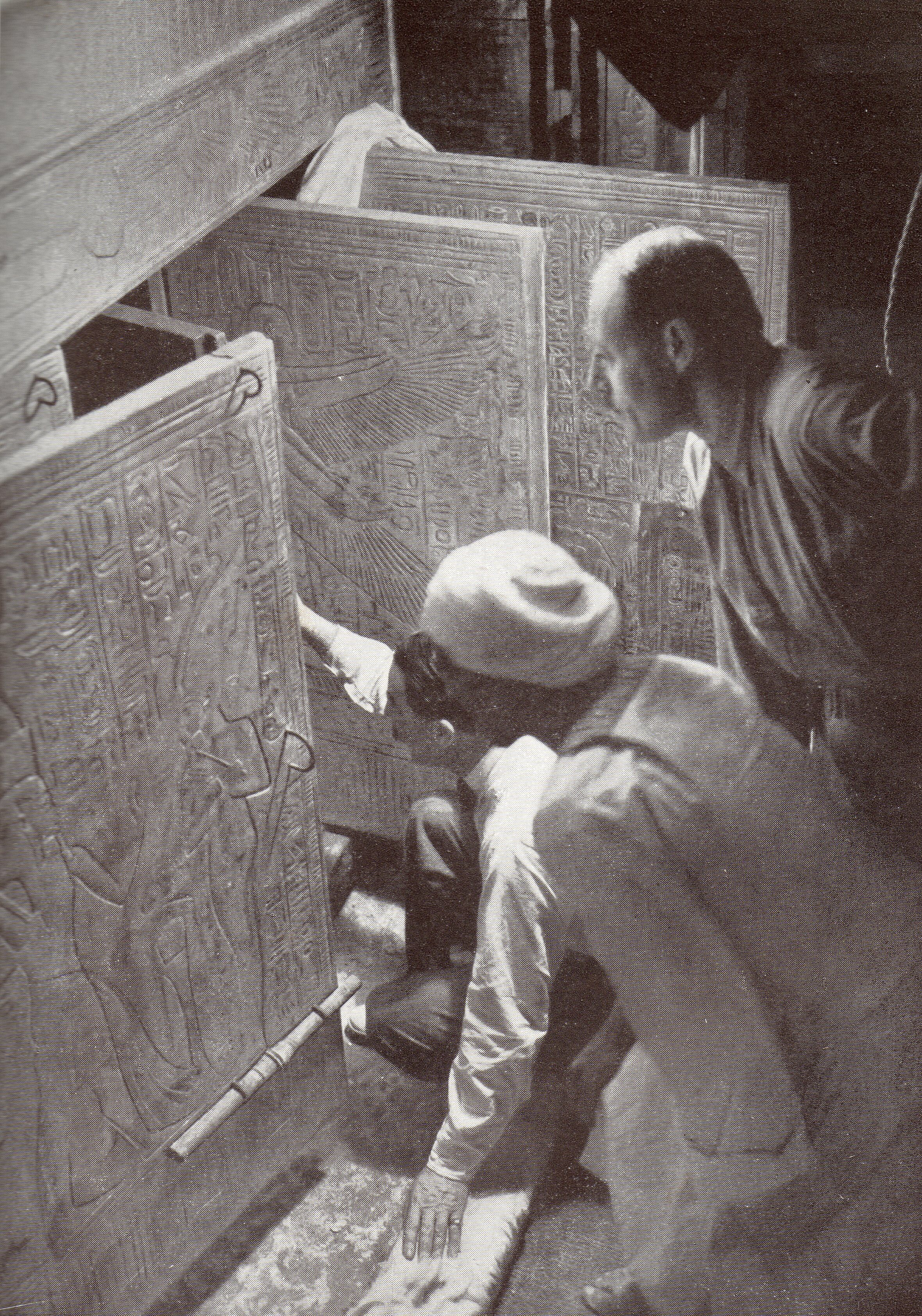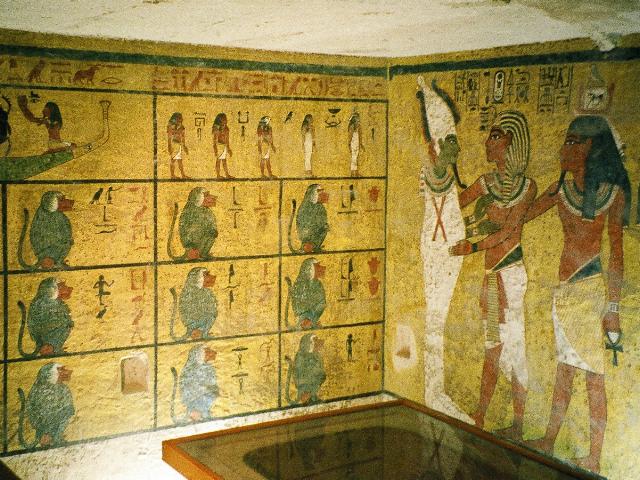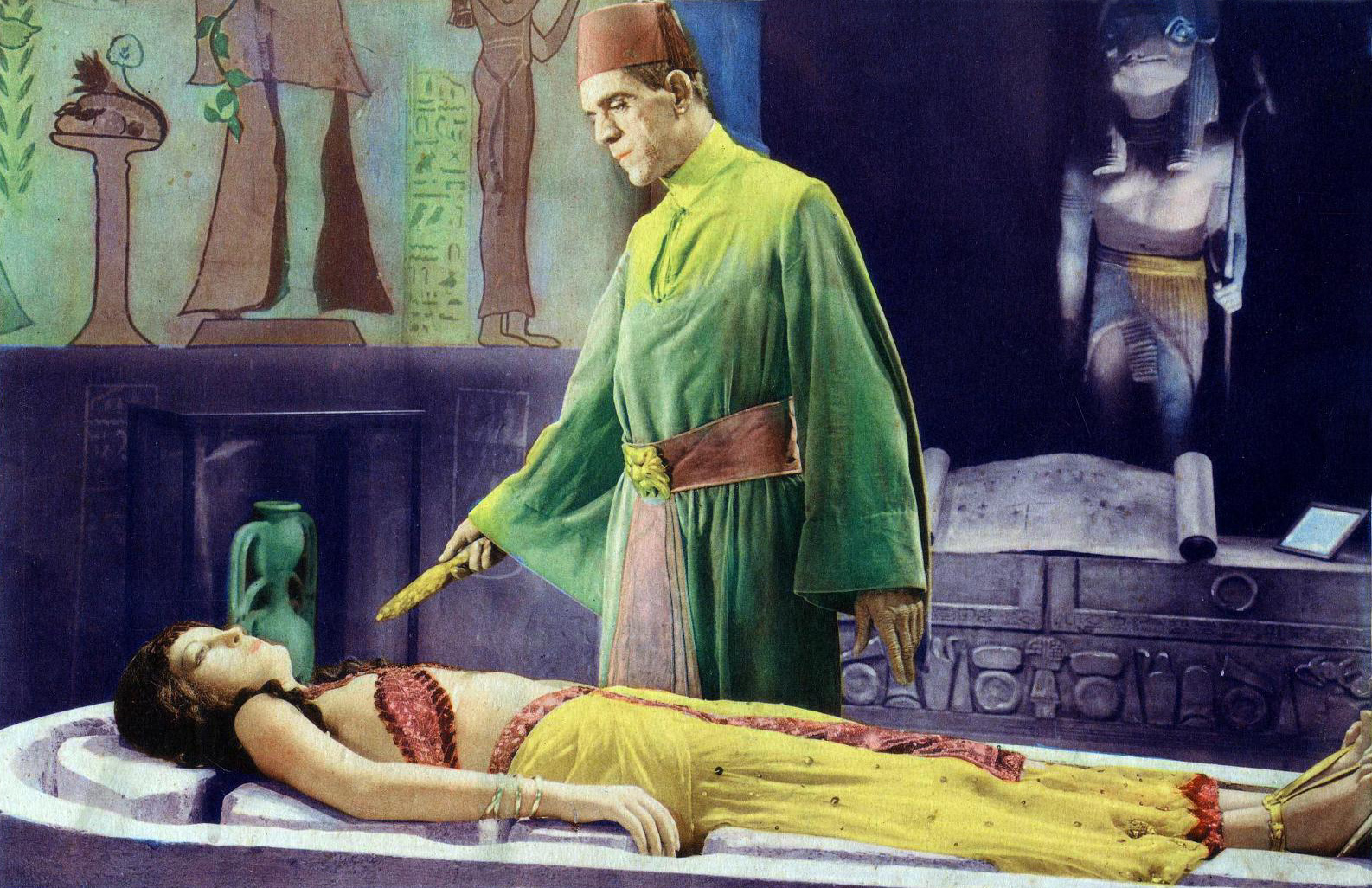|
Tutankhamun
Tutankhamun (, egy, twt-ꜥnḫ-jmn), Egyptological pronunciation Tutankhamen () (), sometimes referred to as King Tut, was an Egyptian pharaoh who was the last of his royal family to rule during the end of the Eighteenth Dynasty (ruled in the conventional chronology) during the New Kingdom of Egyptian history. His father is believed to be the pharaoh Akhenaten, identified as the mummy found in the tomb KV55. His mother is his father's sister, identified through DNA testing as an unknown mummy referred to as " The Younger Lady" who was found in KV35. Tutankhamun took the throne at eight or nine years of age under the unprecedented viziership of his eventual successor, Ay, to whom he may have been related. He married his paternal half-sister Ankhesenamun. During their marriage they lost two daughters, one at 5–6 months of pregnancy and the other shortly after birth at full-term. His names—''Tutankhaten'' and ''Tutankhamun''—are thought to mean "Living image of ... [...More Info...] [...Related Items...] OR: [Wikipedia] [Google] [Baidu] |
Tomb Of Tutankhamun
The tomb of Tutankhamun, also known by its tomb number, KV62, is the burial place of Tutankhamun (reigned c. 1334–1325 BC), a pharaoh of the Eighteenth Dynasty of ancient Egypt, in the Valley of the Kings. The tomb consists of four chambers and an entrance staircase and corridor. It is smaller and less extensively decorated than other Egyptian royal tombs of its time, and it probably originated as a tomb for a non-royal individual that was adapted for Tutankhamun's use after his premature death. Like other pharaohs, Tutankhamun was buried with a wide variety of funerary objects and personal possessions, such as coffins, furniture, clothing and jewellery, though in the unusually limited space these goods had to be densely packed. Robbers entered the tomb twice in the years immediately following the burial, but Tutankhamun's mummy and most of the burial goods remained intact. The tomb's low position, dug into the floor of the valley, allowed its entrance to be hidden by debris d ... [...More Info...] [...Related Items...] OR: [Wikipedia] [Google] [Baidu] |
Discovery Of The Tomb Of Tutankhamun
The tomb of Tutankhamun was discovered in the Valley of the Kings in 1922 by excavators led by the Egyptologist Howard Carter. Whereas the tombs of most pharaohs were plundered in ancient times, Tutankhamun's tomb was hidden by debris for most of its existence and therefore not extensively robbed. It thus became the first known largely intact royal burial from ancient Egypt. The tomb was opened beginning on 4 November 1922 during an excavation by Carter and his patron, George Herbert, 5th Earl of Carnarvon. The unexpectedly rich burial consisted of more than five thousand objects, many of which were in a highly fragile state, so conserving the burial goods for removal from the tomb required an unprecedented effort. The opulence of the burial goods inspired a media frenzy and popularised ancient Egyptian-inspired designs with the Western public. To the Egyptians, who had recently become partially independent of British rule, the tomb became a symbol of national pride, stren ... [...More Info...] [...Related Items...] OR: [Wikipedia] [Google] [Baidu] |
Howard Carter
Howard Carter (9 May 18742 March 1939) was a British archaeologist and Egyptologist who discovered the intact tomb of the 18th Dynasty Pharaoh Tutankhamun in November 1922, the best-preserved pharaonic tomb ever found in the Valley of the Kings. Early life Howard Carter was born in Kensington on 9 May 1874, the youngest child (of eleven) of artist and illustrator Samuel John Carter and Martha Joyce Carter (). His father helped train and develop his artistic talents. Carter spent much of his childhood with relatives in the Norfolk market town of Swaffham, the birthplace of both his parents. Receiving only limited formal education at Swaffham, he showed talent as an artist. The nearby mansion of the Amherst family, Didlington Hall, contained a sizable collection of Egyptian antiques, which sparked Carter's interest in that subject. Lady Amherst was impressed by his artistic skills, and in 1891 she prompted the Egypt Exploration Fund (EEF) to send Carter to assist an Amhe ... [...More Info...] [...Related Items...] OR: [Wikipedia] [Google] [Baidu] |
Mask Of Tutankhamun
The mask of Tutankhamun is a gold mask of the 18th-dynasty ancient Egyptian pharaoh Tutankhamun (reigned 1334–1325 BC). It was discovered by Howard Carter in 1925 in tomb KV62 in the Valley of the Kings, and is now housed in the Egyptian Museum in Cairo. The death mask is one of the best-known works of art in the world and a prominent symbol of ancient Egypt. Bearing the likeness of Osiris, Egyptian god of the afterlife, it is tall, weighs over or 321.5 troy ounces, and is decorated with semi-precious stones. An ancient spell from the ''Book of the Dead'' is inscribed in hieroglyphs on the mask's shoulders. The mask had to be restored in 2015 after its plaited beard fell off and was hastily glued back on by museum workers. According to the Egyptologist Nicholas Reeves, the mask is "not only the quintessential image from Tutankhamun's tomb, it is perhaps the best-known object from ancient Egypt itself." Since 2001, some Egyptologists have suggested that it may origi ... [...More Info...] [...Related Items...] OR: [Wikipedia] [Google] [Baidu] |
Akhenaten
Akhenaten (pronounced ), also spelled Echnaton, Akhenaton, ( egy, ꜣḫ-n-jtn ''ʾŪḫə-nə-yātəy'', , meaning "Effective for the Aten"), was an ancient Egyptian pharaoh reigning or 1351–1334 BC, the tenth ruler of the Eighteenth Dynasty. Before the fifth year of his reign, he was known as Amenhotep IV ( egy, jmn-ḥtp, links=no, meaning " Amun is satisfied", Hellenized as ''Amenophis IV''). As a pharaoh, Akhenaten is noted for abandoning Egypt's traditional polytheism and introducing Atenism, or worship centered around Aten. The views of Egyptologists differ as to whether the religious policy was absolutely monotheistic, or whether it was monolatry, syncretistic, or henotheistic. This culture shift away from traditional religion was reversed after his death. Akhenaten's monuments were dismantled and hidden, his statues were destroyed, and his name excluded from lists of rulers compiled by later pharaohs. Traditional religious practice was gradually restor ... [...More Info...] [...Related Items...] OR: [Wikipedia] [Google] [Baidu] |
Neferneferuaten
Ankhkheperure-Merit-Neferkheperure/Waenre/Aten Neferneferuaten ( egy, nfr-nfrw-jtn) was a name used to refer to a female pharaoh who reigned toward the end of the Amarna Period during the Eighteenth Dynasty. Her sex is confirmed by feminine traces occasionally found in the name and by the epithet ''Akhet-en-hyes'' ("Effective for her husband"), incorporated into one version of her nomen (birth name) cartouche. She is distinguished from the king Smenkhkare who used the same throne name, Ankhkheperure, by the presence of epithets in both cartouches. She is suggested to have been either Meritaten or, more likely, Nefertiti. If this person is Nefertiti ruling as sole pharaoh, it has been theorized by Egyptologist and archaeologist Dr. Zahi Hawass that her reign was marked by the fall of Amarna and relocation of the capital back to the traditional city of Thebes. General chronology There is no broad consensus as to the succession order of Smenkhkare and Neferneferuaten. ... [...More Info...] [...Related Items...] OR: [Wikipedia] [Google] [Baidu] |
Ay (pharaoh)
Ay was the penultimate pharaoh of ancient Egypt's 18th Dynasty. He held the throne of Egypt for a brief four-year period in the late 14th century BC. Prior to his rule, he was a close advisor to two, and perhaps three, other pharaohs of the dynasty. It is theorized that he was the power behind the throne during Tutankhamun's reign. His '' prenomen'' ''Kheperkheperure'' means "Everlasting are the Manifestations of Ra," while his '' nomen'' ''Ay it-netjer'' reads as "Ay, Father of the God." Records and monuments that can be clearly attributed to Ay are rare, both because his reign was short and because his successor, Horemheb, instigated a campaign of '' damnatio memoriae'' against him and the other pharaohs associated with the unpopular Amarna Period. Origins and family Ay is believed to have been from Akhmim. During his short reign, he built a rock-cut chapel in Akhmim and dedicated it to the local deity Min. He may have been the son of the courtier Yuya and his wife Thuya ... [...More Info...] [...Related Items...] OR: [Wikipedia] [Google] [Baidu] |
317a And 317b Mummies
Mummies 317a and 317b were the infant daughters of the Eighteenth Dynasty pharaoh Tutankhamun; their mother is presumed to be his only known wife, Ankhesenamun, who has been tentatively identified as the mummy KV21A. They were buried in their father's tomb, which was discovered by Howard Carter in 1922. Both babies are unnamed, as the coffin inscriptions call them only "the Osiris" (the deceased), so they are known instead by the numbers assigned by Carter during his excavation. They have been examined several times since their discovery, and 317b has been diagnosed with conditions such as Sprengel's deformity and spina bifida, although more recent CT analysis has refuted this. The mummy referred to as 317a is of a girl who was born prematurely at 5–6 months' gestation, and mummy 317b is that of a girl born at or near full term. No cause of death could be determined for either child. Discovery The mummies were buried in Tutankhamun's tomb, in the north-eastern corner o ... [...More Info...] [...Related Items...] OR: [Wikipedia] [Google] [Baidu] |
George Herbert, 5th Earl Of Carnarvon
George Edward Stanhope Molyneux Herbert, 5th Earl of Carnarvon, (26 June 1866 – 5 April 1923), styled Lord Porchester until 1890, was an English peer and aristocrat best known as the financial backer of the search for and excavation of Tutankhamun's tomb in the Valley of the Kings. Background and education Styled Lord Porchester from birth, he was born at 66 Grosvenor Street, Mayfair, London, the only son of Henry Herbert, 4th Earl of Carnarvon, a distinguished Tory statesman, by his first wife Lady Evelyn Stanhope, daughter of Anne and George Stanhope, 6th Earl of Chesterfield. Aubrey Herbert was his half-brother. He was educated at Eton College and Trinity College, Cambridge. He inherited the Bretby Hall estate in Derbyshire from his maternal grandmother, Anne Elizabeth, Dowager Countess of Chesterfield in 1885, and succeeded his father in the earldom in 1890. He was High Steward of Newbury. Family Lord Carnarvon married Almina Victoria Maria Alexandra Wombwell ... [...More Info...] [...Related Items...] OR: [Wikipedia] [Google] [Baidu] |
Ankhesenamun
Ankhesenamun (, "Her Life Is of Amun"; c. 1348 or c. 1342 – after 1322 BC) was a queen who lived during the 18th Dynasty of Egypt as the pharaoh Akhenaten's daughter and subsequently became the Great Royal Wife of pharaoh Tutankhamun. Born Ankhesenpaaten (, "she lives for the Aten"), she was the third of six known daughters of the Egyptian Pharaoh Akhenaten and his Great Royal Wife Nefertiti. She became the Great Royal Wife of Tutankhamun. The change in her name reflects the changes in ancient Egyptian religion during her lifetime after her father's death. Her youth is well documented in the ancient reliefs and paintings of the reign of her parents. The mummy of Tutankhamun's mother has been identified through DNA analysis as a full sister to his father, the unidentified mummy found in tomb KV55, and as a daughter of his grandfather, Amenhotep III. So far his mother's name is uncertain, but her mummy is known informally to scientists as the Younger Lady. Ankhesenamun was well ... [...More Info...] [...Related Items...] OR: [Wikipedia] [Google] [Baidu] |
KV55
KV55 is a tomb in the Valley of the Kings in Egypt. It was discovered by Edward R. Ayrton in 1907 while he was working in the Valley for Theodore M. Davis. It has long been speculated, as well as much disputed, that the body found in this tomb was that of the famous king, Akhenaten, who moved the capital to Akhetaten (modern-day Amarna). The results of genetic and other scientific tests published in February 2010 have confirmed that the person buried there was both the son of Amenhotep III and the father of Tutankhamun. Furthermore, the study established that the age of this person at the time of his death was consistent with that of Akhenaten, thereby making it almost certain that it is Akhenaten's body.Hawass, Zahi et al. "Ancestry and Pathology in King Tutankhamun's Family" ''The Journal of the American Medical Association'' (2010) p. 644 However, a growing body of work soon began to appear to dispute the assessment of the age of the mummy and the identification of KV55 as Akhen ... [...More Info...] [...Related Items...] OR: [Wikipedia] [Google] [Baidu] |
Amarna Period
The Amarna Period was an era of Egyptian history during the later half of the Eighteenth Dynasty when the royal residence of the pharaoh and his queen was shifted to Akhetaten ('Horizon of the Aten') in what is now Amarna. It was marked by the reign of Amenhotep IV, who changed his name to Akhenaten (1353–1336 BC) in order to reflect the dramatic change of Egypt's polytheistic religion into one where the sun disc Aten was worshipped over all other gods. The Egyptian pantheon was restored under Akhenaten's successor, Tutankhamun. Religious developments Akhenaten instigated the earliest verified expression of a form of monotheism, although the origins of a pure monotheism are the subject of continuing debate within the academic community. Some state that Akhenaten restored monotheism while others point out that he merely suppressed a dominant solar cult by the assertion of another, while never completely abandoning several other traditional deities. Scholars believe that Akhe ... [...More Info...] [...Related Items...] OR: [Wikipedia] [Google] [Baidu] |



.jpg)




.jpg)
